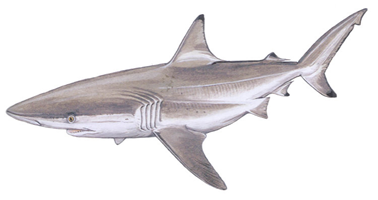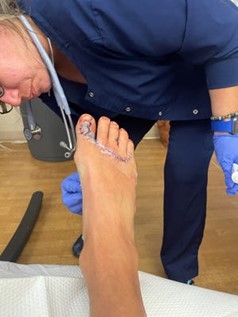On March 12, thirty-six-year-old Mathew Picarelli was body surfing off Pepper Park Beach in St. Lucie County, Florida when he was suddenly bit by a shark. A bystander who witnessed this event noted the shark to be a 4-5 foot spinner shark. Matthew is reported to have sustained a torn tendon, minor fracture, and large laceration in his right foot requiring fifty stitches at Florida Lawnwood Hospital.

Mathew Picarelli resting his foot after treatment. From TCPalm.
The United States has one of the largest reported shark attack hubs in the world, around the beaches of New Smyrna, Florida. Despite the presence these areas of frequent attacks and the media attention that comes with them, the overall likelihood of being bitten by a shark remains extremely low (less than 1 in 11.5 million*). Many of these reported cases of unprovoked attacks occurred while victims were surfing or participating in other board sports.

Spinner shark from the Shark Research Institute
Prevention
Although shark attacks are overall rare, there are some actions that can be taken to further decrease the risk of an attack. Sharks may attack due to one of the following reasons: perceiving humans as food (uncommon), perceiving humans as a threat or a competitor, or sharks protecting their territory from humans. According to the Global Shark Attack File, there are several recommendations to decrease risk of an unnecessary attack:
• Seek advice from locals before engaging in water activities where shark attacks have occurred.
• Remain aware of your surroundings.
• If you see a shark, do not harass or touch it, no matter its size.
• If swimming or surfing do not enter the water when sharks are present and leave the water if you are requested to do so by a lifeguard or other professional.
• Common areas sharks can be seen include close to river mouths, breakers, sandbars, jetties, and areas where any type of fishing activity is taking place or offal is dumped into the sea.
• If spearfishing or collecting shellfish, do not attach your catch to a stringer at your waist and stay alert when removing a fish from your spear. If wade-fishing, do not carry bait on your person.
Wound Management

Patient’s foot laceration after repair. From TCPalm.
Shark bites are often evaluated on a case-by-case basis due to their varied presentations. However, there are several recommendations when it comes to general treatment of these wounds. After appropriate hemorrhage control, thorough wound cleaning is essential. This may entail superficial irrigation for simple wounds or surgical debridement for severe wounds with significant loss of tissue, evidence of necrotic tissue, or evidence of vascular or neurological deficits. Wound exploration to search for any foreign bodies including teeth fragments should be considered. Imaging, including x-ray, CT, or ultrasound, has shown to be useful in finding retained foreign bodies. In addition to soft-tissue, neurologic and vascular injuries patients should also be assessed for associated fractures or underlying organ injuries. There are no current consensus recommendations on the decision for wound closure, which varies on the type and extent of injury, risk of infection, and cosmetic and functional outcomes. Prophylactic antibacterial coverage is recommended for all shark bites as well as an up-to-date tetanus vaccine. Specific coverage considerations for Vibrio species as well as staphylococcus and streptococcus should be considered.
*as of 1/2024, this number has been updated to 1 in 4,332,817.